#artist is hans makart
Explore tagged Tumblr posts
Text
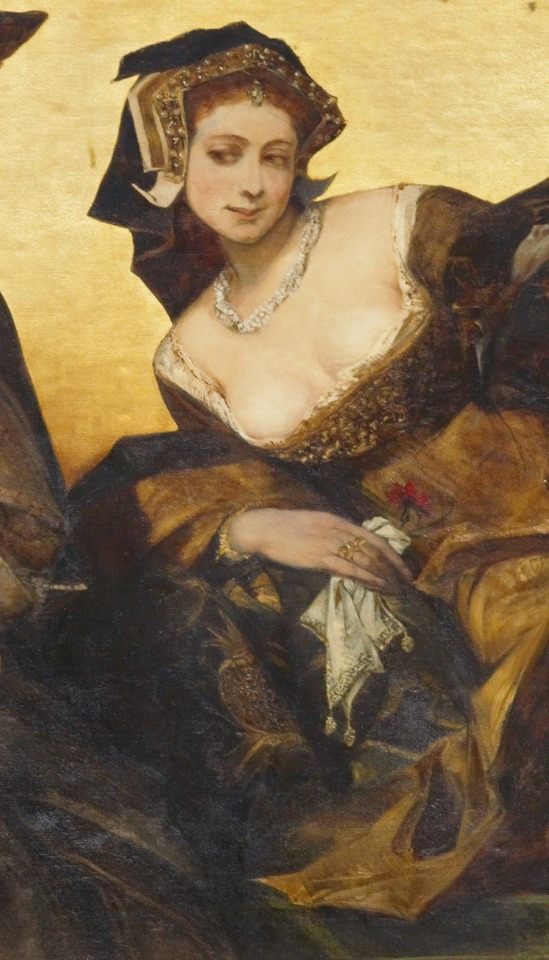
Hans Holbein the Younger by Hans Makart (1882-1884)
#art#art history#art painting#painting#19th century#19th century art#hans makart#austrian art#austrian artist#women in art#women in paintings#art detail#art details
3K notes
·
View notes
Text

~ Hans Makart, Magdalena Plach (1870) (detail)
via retalesuy
#hans makart#painting#fine art#art history#painting detail#austrian art#austrian artist#19th century painting#19th century art#portrait painting#portraiture#victorian art#victorian#victorian era#victoriana#victorian aesthetic#victorian painting#1870s#1870s art#1870#e
16 notes
·
View notes
Text

Hans Makart, Clothilde Beer
#hans makart#powerpoint slide#female portrait#austrian painter#Clothilde Beer#classical painting#artwork#austrian artists
1 note
·
View note
Text
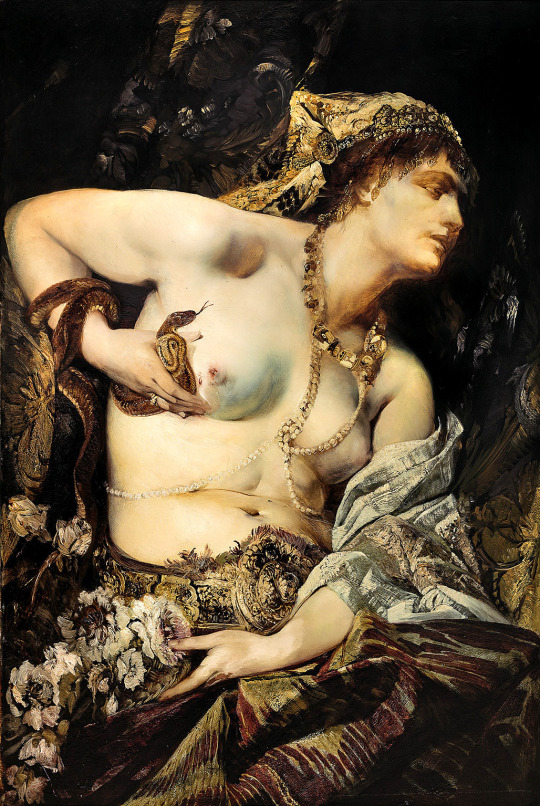
Hans Makart, The Death of Cleopatra, 1875.
Liechtenstein, The Princely Collection
Hans Makart was a 19th-century Austrian academic history painter, designer, and decorator. He is best known for his influence on Gustav Klimt and other Austrian artists, but in his own era he was considered an important artist himself and a celebrity figure in the high culture of Vienna and attended with almost cult-like adulation.
Makart was the son of a chamberlain at the Mirabell Palace in Salzburg, Austria, born in the former residence of the prince-archbishops of Salzburg, the city in which Mozart had been born. Initially, he received his training in painting at the Vienna Academy between 1850 and 1851 from Johann Fischbach. While in the Academy, German art was under the rule of a classicism, which was entirely intellectual and academic—clear and precise drawing, sculpturesque modelling, and pictorial erudition were esteemed above all. Makart, who was a poor draughtsman, but who had a passionate and sensual love of color, was impatient to escape the routine of art school drawing. For his fortune, he was found by his instructors to be devoid of all talent and forced to leave the Vienna Academy.
#hans makart#painting#cleopatra#1875#the death of cleopatra#death#makart#snake#art#Liechtenstein#The Princely Collection#history painting#history#cleopatra vii#Orientalist painters#art history#history painter#austrian#austrian art#snake bite#snake bites#Mirabell palace#1870s#1870s art#1870s paintings#1875 painting#inspo jewellry#inspiration
63 notes
·
View notes
Text

The Secret Salon
The Late 19th Century: A Time of Change in Art and Culture
The late 19th century was marked by profound cultural, technological, and societal changes. While movements like Historicism, Academicism, and Symbolism dominated the art world, a hidden subculture of LGBT artists also emerged, meeting in private salons and circles to explore their identities.
Historicism and Academicism Historicism focused on reviving past styles such as Gothic and Renaissance. In architecture and painting, historical themes were used to create dramatic or heroic effects. A prominent figure was the Austrian painter Hans Makart, known for his opulent historical paintings.
At the same time, Academicism flourished, supported by the art academies. This movement valued technical perfection and the depiction of idealized bodies. Artists like Jean-Léon Gérôme and William-Adolphe Bouguereau created works influenced by mythological and erotic themes. Sensuality played a central role, particularly in depictions of male and female beauty.
Secret LGBT Gatherings and Artistic Salons While these artistic movements were celebrated publicly, private salons emerged where LGBT artists and intellectuals met. In cities like Paris, Berlin, and Vienna, these gatherings took place behind closed doors, as homosexuality was socially taboo. Such salons provided a safe space for intimate and sensual encounters as well as the exchange of ideas.
Oscar Wilde and Magnus Hirschfeld were well-known figures who used these spaces to freely explore their sexuality and art. These gatherings often became moments of inspiration, celebrating both artistic and social freedom.
Symbolism: Exploring the Mystical and the Sensual Symbolism emerged as a counter-movement to Academicism, seeking new ways to explore the deeper, spiritual aspects of human experience. Artists like Gustave Moreau and Arnold Böcklin focused on allegorical and mystical themes, often incorporating erotic undertones.
Gustav Klimt combined both sensual and mystical elements in works like "The Kiss," creating an artistic fusion of sexuality and transcendence.
Conclusion The late 19th century was a time of change and contradictions: while the art world was dominated by traditional movements like Historicism and Academicism, hidden LGBT artist circles explored new forms of sensuality and artistic expression through intimate gatherings and salons. This era marked a transition into modernity and laid the groundwork for the radical artistic innovations of the 20th century.
Text supported by GPT-4o Image generated with SD1.5. Overworked with inpainting (SD1.5/SDXL) and composing.
20 notes
·
View notes
Text

A Japanese Princess Going to Church
Artist: Gyula Tornai (Hungarian, 1861-1928)
Date: 1906
Gyula Tornai was a Hungarian painter, now featured in the Hungarian National Gallery. He was a noted painter in the Orientalist genre.
Tornai was born in Görgö, Hungary (today Spišský Hrhov, Slovakia), in 1861. He received his art education at academies in Vienna, Munich and at Benczúr's Studios in Budapest where he studied under Hans Makart and Gyula Benczúr. His initial paintings were pictures of popular everyday themes such as the Good Fat, Camelian Lady. His style was heavily influenced by Makart (Makartstil or "Makart’s style" in German).
Following his travels to Spain, Algeria and Morocco, he turned to more exotic themes and painted works depicting street life, merchants, musicians and harems. He spent 10 years in Morocco and lived in Tangiers for a year between 1890 and 1891. In 1900, he exhibited pictures in the Exposition Universelle in Paris to great acclaim, winning the bronze medal. In 1904, he sold many of his works to raise money for further travel.
In the Summer of 1905, he travelled to Far-East where he continued his interest in Orientalist themes. During this period he travelled through India and Japan. Shortly after his arrival in Japan, he painted a portrait of the former Prime-Minister, Count Okuma, who became an influential patron. This patronage gave him unprecedented access to many facets of Japanese life and customs that had previously been hidden from Europeans. This allowed him to explore Buddhism and Shintoism in depth. Tornai remained in Japan for 16 months during which time he painted such works as A Japanese Princess Going to Church, Geisha, The Geisha House and the Samurai Warrior amongst other paintings.
In 1907 he was exhibited in Paris and London; in 1909 at Budapest in the Műcsarnok; in 1917 at the National Salon. In 1929, the auction hall organized an exhibition of legacies from his works.
His Oriental works gained him international recognition during his own lifetime. A contemporary source commented that his works from this period, ”the like of which for glory of colour and intense appreciation of the picturesqueness of the east had not been seen before.” His paintings are also noted for their irony, humour and wit. For instance, his painting The Connoisseurs features a group of locals, possibly Berbers, gathered in the artist's studio critically examining a painting of Oriental men. These men were probably the subject of the painting. He also gave viewers glimpses of another world with his depictions of Oriental customs and practices. Several of Tornai's paintings are held in the Hungarian National Gallery.
#genre art#gyula tornai#hungarian painter#early 20th century painting#japanese architecture#church#women#japan#kimono
16 notes
·
View notes
Text

Die Nixen und der Tiger (The Mermaids and the Tiger) ~ 1872/73 ~ Hans Makart (Austrian academic history painter, designer, and decorator; most well known for his influence on Gustav Klimt and other Austrian artists, but in his own era considered an important artist himself and a celebrity figure in the high culture of Vienna, attended with almost cult-like adulation, 1840-1884)
25 notes
·
View notes
Text

THE MERMAIDS (1871) by IVAN KRAMSKOI
THE MERMAIDS (also known as Drowned Maidens, Russian: Русалки) portrays 19 RUSALKI. RUSALKI are river or lake spirits that appear at night as young women in SLAVIC mythology.
Some versions of the myths describe them as spirits who had died unbaptised or unmarried, or had drowned themselves following an unrequited love. They would come out of the water in the middle of the night, singing and dancing. They had a lot in common with sirens; they would seduce young men and then lure them under the water to their death.
The painting is inspired by the works of ALEKSANDR PUSHKIN and NIKOLAI GOGOL, who wrote the 1831 fantastic story “A MAY NIGHT” (or “DROWNED MAIDENS”) and shows that, despite the realist ideas of the newly established Peredvizheniki movement, the artist was still interested in more romantic fantasies and fairytale themes.
Set at night, the painting is almost entirely without colour. The women sit in the middle of the painting, and the moonlight illuminates them from above on the left-hand side of the canvas. The light illuminates the shadows unevenly.
The majority of the women are grouped in a line, with a few at the bank’s edge or to the right, lost in thought. On the left foreground, the last of KRAMSKOI’S rusalki emerges from the reeds, and in the background, a woman is wringing water out of her hair.
The water bank is located at the base of a steep hill surrounded by deep forest on the right. On the top of the little hill and against the right is a small cabin that appears to be vacant. The theme and style of the painting are most likely inspired by the work of Hans Makart, a HUNGARIAN painter and designer.
1 note
·
View note
Text

The Death of Cleopatra by Hans Makart (1875–1876)
#art#art history#art painting#painting#oil on canvas#historical art#historical painting#old art#19th century#19th century art#hans makart#austrian art#austrian artist#women in art#ancient women#cleopatra
171 notes
·
View notes
Text
Hansy's Spank Bank
HANSY: Have you prayed tonight, Desdemona? (He pulls a reproduction of Palma Vecchio’s Venus from underneath his shirt.) Our father, who art in Heaven? You don’t look like it, my love – rapt in your expectation of what’s coming, as in that sweet moment of budding ecstasy when I saw you lying in the window of Jonathan Schlesinger’s—your supple legs and arms, the gentle curving of your hips, your firm young breasts…
If I wanted to count them—all the departed with whom I’ve fought the same battle here!—Thuman’s Psyche—another legacy of the hatchet-faced Mademoiselle Angelique, that rattlesnake in the paradise of my childhood; Correggio’s Io; Lossow’s Galatea; then a cupid by Bouguereau; J. van Beer’s Ada, whom I had to abduct from a secret compartment in Papa’s desk in order to add her to my harem; a quivering, twitching Leda by Makart that I happened to find in my brother’s lecture notes…
But my conscience will be pacified, my body will regain its strength when you, devil, no longer reside in the red satin cushions of my jewel box. In your place I’ll invite Bodenhousen’s Lurlei or Linger’s Forsaken Maiden or Defregger’s Loni to move into this sumptuous chamber of pleasure…
-- Act 2, Scene 3 of Spring Awakening by Frank Wedekind, translated by Jonathan Franzen
So what is in Hansy's spank bank? What images would a teenage boy in provincial Germany in the 1890s be getting off to? And why has no one put together a post like this before?
Palma Vecchio's Venus...
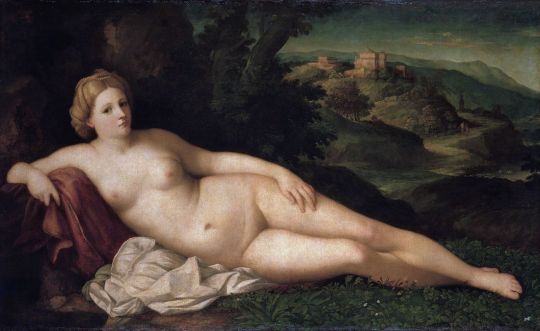
Resting Venus by Jacopo Palma Vecchio, 1520s
Thuman’s Psyche...
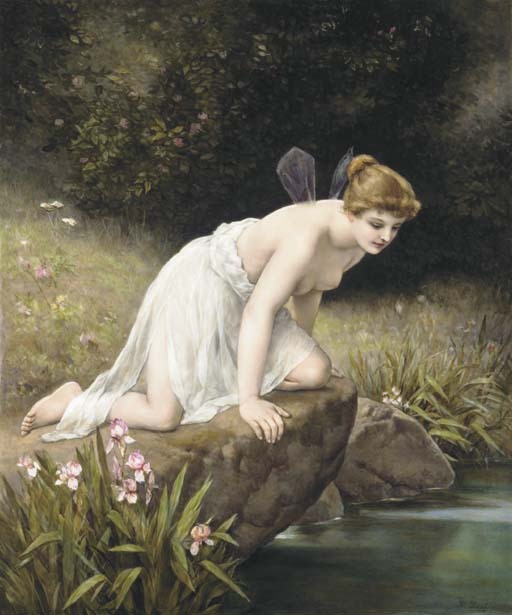
Psyche am Wasserspiegel by Paul Thumann, 1890s
Correggio’s Io...

Jupiter and Io by Correggio, c. 1530
Lossow’s Galatea...
I could not find any good candidates online for this painting, but note that the wikipedia page for Heinrich Lossow (1843-1897) calls him "a prolific pornographer".
A cupid by Bouguereau...
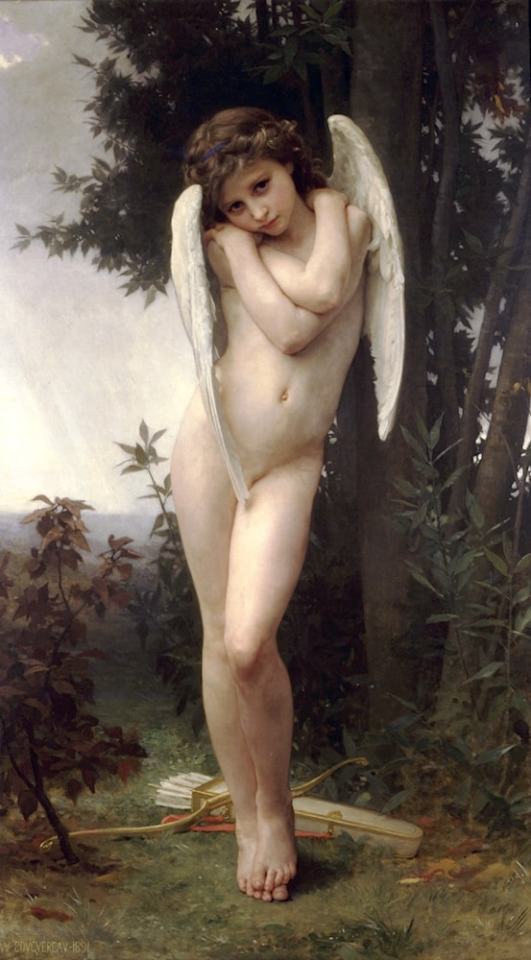
perhaps L'amour Mouille (Wet Cupid) by William-Adolphe Bouguereau, 1891
J. van Beer’s Ada...
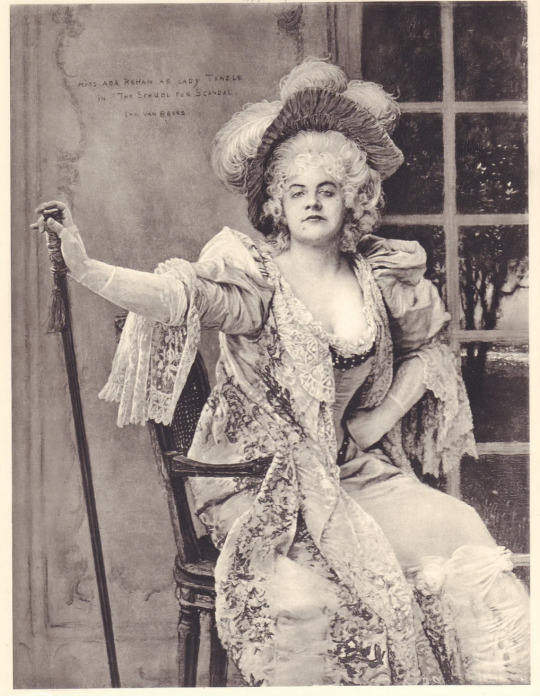
Portrait of Miss Ada Rehan as Lady Teazle in the "School for Scandal" by Jan van Beers, 1890s (this doesn't seem quite right but is the only candidate I could find?)
Leda by Makart...
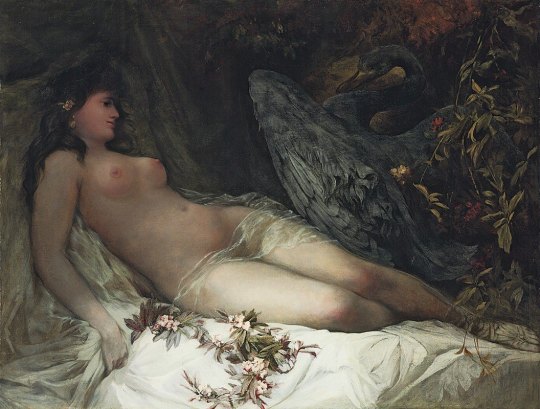
Leda and the Swan by Hans Makart, 1868
Bodenhousen’s Lurlei...
Could not find a candidate for this either, not a lot of artwork by Cuno von Bodenhausen (1852-1931) seems to be online
Linger’s Forsaken Maiden...
Cannot find this online or even figure out what artist Hansy is referring to
Defregger’s Loni...
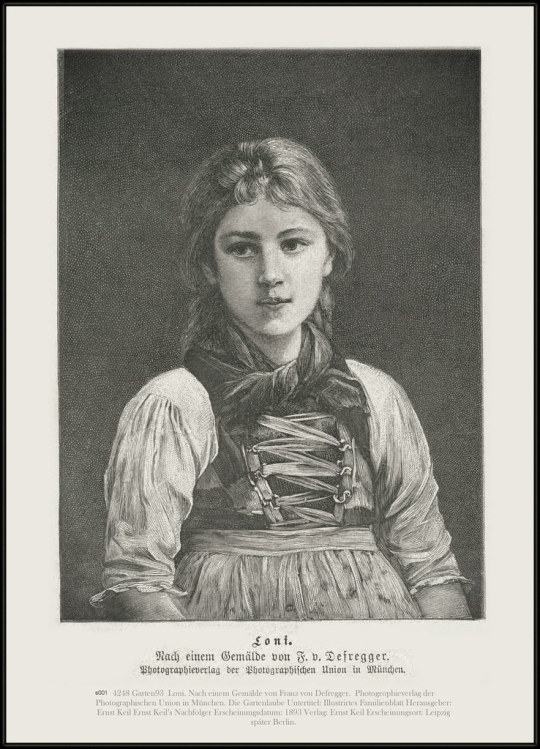
Loni by Franz von Defregger, 1890s
1 note
·
View note
Photo

Allegory of Love by Hans Makart (19th Century)
#hans makart#art#paintings#fine art#19th century#19th century art#academism#academicism#academic art#painting#austrian art#austrian artist#allegory#mythology#greek mythology#aphrodite#venus#love#classic art
2K notes
·
View notes
Text

Hans Makart (1840-1884) “The Valkyrie” (1877) Oil on panel Located in the Bass Museum of Art, Miami Beach, Florida, United States
#paintings#art#artwork#mythological painting#female portrait#hans makart#oil on panel#oil on wood panel#fine art#austrian artist#the bass museum of art#museum#art gallery#norse mythology#valkyrie#gold armor#armour#golden#weapons#weaponry#weapon#spear#1870s#late 1800s#late 19th century#side profile
369 notes
·
View notes
Text
Hans Makart Revisited
Self Portrait by Hans Makart (1878) The artist I am looking at today, and had written about in 2013, was one who was revered by many of the art critics of the time and yet hated by others, who baulked at his general lack of interest in factual accuracy in his depictions and for disparaging important episodes in history by including unwarranted female nudity in his paintings. It would appear…

View On WordPress
2 notes
·
View notes
Photo

Hans Makart (1840-1884), 'The Hunting Party of Diana', ''Die Kunst für alle'', 1894-95 Source
#hans makart#austrian artists#austrian painters#The Hunting Party of Diana#diana#roman myth#roman mythology#goddess of the hunt#die kunst für alle
409 notes
·
View notes
Text

ineffable details from musikalische unterhaltung, 1874
#photo#personal#my art#good omens#ineffable husbands#crowley#aziraphale#ineffable wives#repaint#painting#art#artists on tumblr#azicrow#anthony j crowley#a z fell#fanart#hans makart#musikalische unterhaltung#oil painting#ugh how do u tag lmao#anyway.
1K notes
·
View notes
Text

The Young Eastern Woman, 1838
Artist: Friedrich von Amerling (Austrian, 1803-1887)
Medium: Oil on Fabric
Location: The Cleveland Museum of Art, Cleveland, Ohio
Description
Although the artist provocatively titled this painting Young Eastern Woman, it is obvious that the model is not Asian, but merely wears a Turkish costume. The rich fabrics and glowing light create an exotic atmosphere, revealing a Western fascination with "Oriental" images and themes.
Biography
Friedrich Amerling grew up in a poor working-class milieu and started his career illuminating maps and prints before attending the Vienna academy from 1815 until 1824. The following two years he studied at the academy in Prague, until his sojourn in London from 1827 through 1828. Amerling went to London primarily to meet the portraitist Thomas Lawrence (1769-1830), whose fame had spread throughout Europe and whose work, together with that of Joshua Reynolds (1723-1792), would form an important influence on Amerling's art. After a brief stay in Paris, during which Amerling met Vernet, he went on to Rome.
Back in Vienna he painted the life-size portrait of Emperor Franz I (1832/33, Kunsthistorisches Museum, Vienna), which, despite its mixed reviews, established his reputation as the foremost portrait painter in Vienna. From then on he received many portrait commissions from the Viennese aristocracy. In 1833 Amerling traveled to the Netherlands and, upon his return, visited the artistic centers of Munich and Düsseldorf, where he met the influential academy director Friedrich Wilhelm von Schadow (1788-1862).
Amerling's career reached its height from the 1830s through the 1850s. In the early 1840s he traveled to Rome where he worked with Leopold Pollak (1806-1880) and August Riedel (1799-1883), who influenced his work with their depictions of Italian beauties. Besides painting formal portraits, Amerling developed a painting category that remained close to portraiture but crossed over to a slightly sentimental type of genre or character painting, mostly depicting single women in coquettish poses. Although Amerling retained a certain popularity throughout his long career-he was knighted in 1879-he failed to adapt to changing artistic developments and was eventually overshadowed by artists such as Hans Makart (1840-1884).
#friedrich von amerling#oil painting#oil on fabric#austrian art#austrian artist#cleveland museum of art
13 notes
·
View notes